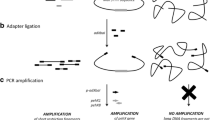Abstract
Pseudomonas cepacia is an important nosocomial pathogen for which measures of isolate relatedness are being developed. Typing systems based on 4 different strain characteristics have been proposed: serologic reactions, biochemical reactions, plasmid profiles, and Bacteriocin production and susceptibility. Serology and bacteriocins distinguish many types, but the sensitivity and specificity of these techniques have not been determined. Improved methods for typing P. cepacia are needed to determine the reservoirs and modes of transmission of this emerging nosocomial pathogen.
Similar content being viewed by others
References
Aronoff S.C., Klinger J.D. (1985): Comparison of cepiramide (HR-810) and four anti-pseudomonal beta-lactam agents against pseudomonas isolates from children with cystic fibrosis. - J. Antimicrob. Chemother., 15: 545–9.
Ederer G.M., Matsen J.M. (1972): Colonization and infection with Pseudomonas cepacia. - J. Infect. Dis., 125: 613–8.
Esanu J.G., Schubert R.H.W. (1973): Taxonomy and nomenclature of Pseudomonas cepacia, - Zbl. Bakt. Hyg., I Abt. Orig. A, 224: 478–83.
Geiss H.K., Piotrowski H.D., Hingst V. (1985): Evaluation of APT 20 NE in routine diagnostics of nonfermenting gram-negative rod-shaped bacteria.- Zbl. Bakt. Hyg. A, 259: 35–42.
Gonzalez C.F., Vidader A.K. (1979): Bacteriocin, plasmid and pectolytic diversity in Pseudomonas cepacia of clinical and plant origin. - J. Gen. Microbiol., 110: 161–70.
Govan J.R., Harris G. (1985): Typing of Pseudomonas cepacia by bacteriocin susceptibility and production. -J. Clin. Microbiol., 22: 490–4.
Heidt A., Monteil H., Richard C. (1983): O and H serotyping of Pseudomonas cepacia. - J. Clin. Microbiol., 18: 738–40.
Isles A., Maclusky I., Corey M., Gold R., Prober C., Fleming P., Levison H. (1984): Pseudomonas cepacia infection in cystic fibrosis: an emerging problem. - J. Pediatr., 104: 206–10.
Jarvis W.R., Olson D., Tablan O.C., Martone W.J. (1987): The epidemiology of nosocomial Pseudomonas cepacia infections: Endemic infections. -Eur. J. Epidemiol., 3: 233–6.
John J.F., Twitty J.A. (1986): Plasmids as epidemiologic markers in nosocomial gram-negative bacilli: Experience at a university and review of the literature. - Rev. Infect. Dis., 8: 693–704.
Jonsson V. (1965): Studies to characterize the gram-negative bacilli designated as eugonic oxidizers group number one. Doctoral dissertation, Univ. N. Carolina, Chapel Hill.
Kaper J.B., Bradford H.B., Roberts N.C., Falcow S. (1982): Molecular epidemiology of Vibrio cholerae in the U.S. Gulf Coast. - J. Clin. Microbiol., 16: 129–34.
Khabbaz R.F., Kaper J.B., Moody M.R., Schimpff S.C., Tenney J.H. (1986): Molecular epidemiology of group JK Corynebacterium on a cancer ward: Lack of evidence for patient-to-patient transmission.- J. Infect. Dis., 154: 95–99.
Klinger J.D., Bajaksouzian S., Klayman S. (1986): Pseudomonas cepacia in cystic fibrosis patients (abstract). - Cystic Fibrosis Club Abstr., 27: 115.
Kristiansen B.E., Sorensen B., Spanne O., Bjorvatn B. (1985): Restriction fingerprinting and serology in a small outbreak of B15 meningoeoccal disease among Norwegian soldiers. - Scand. J. Infect. Dis., 17: 19–24.
Marshall R.B., Winter P.J., Robinson A.J., Bettelheim K.A. (1985): A study of enterotoxigenic Escherichia coli, serogroup 0126, by bacterial restriction endonuclease DNA analysis (BRENDA). - J. Hyg. (Camb.), 94: 263–8.
Martone W.J., Tablan O.C. and Jarvis W.R. (1987): The epidemiology of epidemic Pseudomonas cepacia infections. - Eur. J. Epidemiol., 3: 222–32.
McKevitt A.I., Retzer M.D., Woods D.E. (1986): Development and use of a serotyping scheme for Pseudomonas cepacia (abstract), - Abstr. ICAAC, 26: 394.
McKevitt A.I., Woods D.E. (1984): Characterization of Pseudomonas cepacia isolates from patients with cystic fibrosis (abstract). - Abstr. Ann. Meeting Amer. Soc. Microbiol., 84: 44.
Monteil H., Peladan F., Zinsius M. (1984): Activite comparee de l'azlocilline sur Pseudomonas species a l'exception de Pseudomonas aeruginosa. - Presse Med., 13: 780–4.
Nakamura Y., Hyodo S., Chonan E., Shigeta S., Yabuuchi E., (1986): Serological classification of Pseudomonas cepacia by somatic antigen. - J. Clin. Microbiol., 24: 152–4.
Penner J.L., Hennessy J.N., Mills S.D., Bradbury W.C. (1983): Application of serotyping and chromosomal restriction endonuclease digest analysis in investigating a laboratory-acquired case of Campylobacter jejuni enteritis. - J. Clin. Microbiol., 18: 1427–8.
Plorde J.J., Gates J.A., Carlson L.G., Tenover F.C. (1986): Critical evaluation of the AutoMicrobic system Gram-Negative Identification card for identification of glucose-nonfermenting gram-negative rods. - J. Clin. Microbiol., 23: 251–7.
Prince A.S., Scott N.B. (1984): Antibiotic resistance plasmids in Pseudomonas cepacia (abstract). -Abstr. ICAAC, 24: 265.
Richard C., Monteil H., Megraud F., Chatelain R., Laurent B. (1981): Phenotype characteristics of 100 strains of Pseudomonas cepacia. Proposition of a biovars classification. - Ann. Biol. Clin., 39: 9–15.
Santos Ferreira M.O., Manuela Canica M., Jesus Bacelar M. (1985): Pseudomonas cepacia: The sensitivity of nosocomial strains to new antilbotics. -J. Int. Med. Res., 13: 270–5.
Stevens M., Henrichsen C., Smith M. (1986): A collaborative evaluation of a rapid, semi-automated identification system for gram-negative bacilli: The Quantum II BID. - J. Med. Microbiol., 21: 145–50.
van Ketel R.J., ter Schegget J., Zanen H.C. (1984): Molecular epidemiology of Legionella pneumophila serogroup 1. - J. Clin. Microbiol., 20: 362–4.
Author information
Authors and Affiliations
Rights and permissions
About this article
Cite this article
Rabkin, C.S., Jarvis, W.R. & Martone, W.J. Current status of Pseudomonas cepacia typing systems. Eur J Epidemiol 3, 343–346 (1987). https://doi.org/10.1007/BF00145643
Issue Date:
DOI: https://doi.org/10.1007/BF00145643




